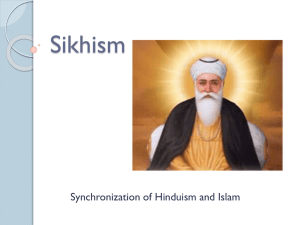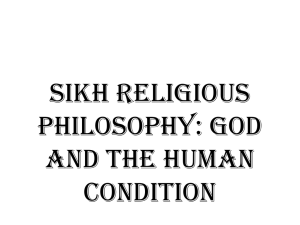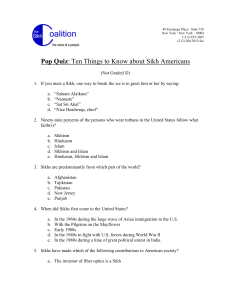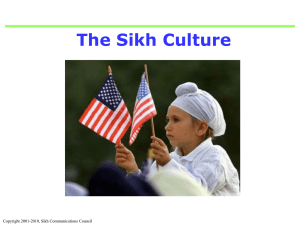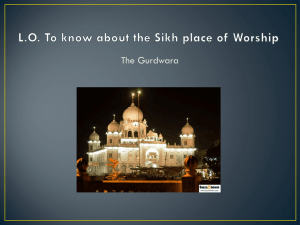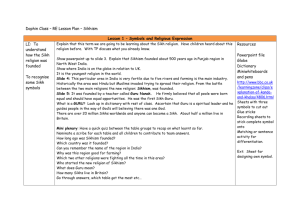REL2300T SikhismS2015
advertisement
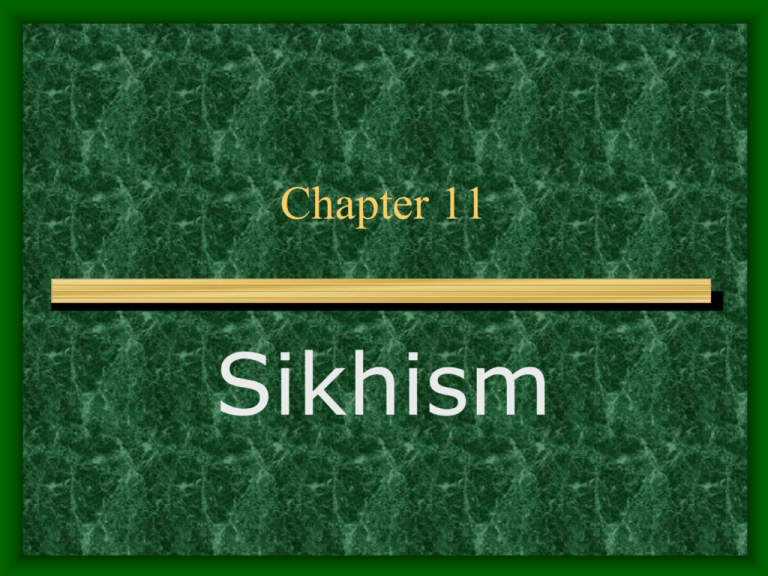
Chapter 11 Sikhism Sikhism Quotes • “There is neither Hindu nor Mussulman [Muslim], so whose path shall I follow? I shall follow God’s path. God is neither Hindu nor Mussulman.” Guru Nanak • “Same are the temple and the mosque, and same are the forms of worship therein. All human beings are one though apparently many, realize, therefore, the essential unity of mankind.” Guru Gobind Singh, Dasam Granth Sikhism Learning Objectives • Know, classify, identify, comprehend, and express all the concepts/terms, the thought patterns, the teachings, beliefs, practices, and divisions of Sikhism, its Scriptures origin, historical development, its geographic center, and • Be able to articulate, express, explain, analyze, and discuss all the above • Be able to identify, comprehend, and express the components/ elements of syncretism from other religions incorporated into Sikhism • Comprehend and explain the political and religious context and causal influences that helped shape this religion Sikhism’s Key Terms • Sikh • Kabir • Guru Arjan Dev • Adi Granth/ Guru • Amrit Amritsar • Pranth Sangat • Langar • Khalsa Sikhism Nam Guru Nanak Guru Gobind Singh Granth Sahib Golden Temple Punjab Gurdwara Takht The Five K’s Singhs Udasis Sikhism Introduction (1) • Origin: Historical Geographical Political Cultural, Religious Contexts • An attempted synthesize of Hinduism and Islam • Some scholars: developed in the context of a religious conversation between devotional Hinduism and Islamic mysticism • Sikh devotions are very simple Sikhism Introduction (2) • M. Fisher textbook: their Sikh “path is not another sectarian religion but a statement of universal truth within, and transcending all religions.” p. 440 • Hopfe Woodward textbook: Sikhs believe their faith to be a new and independent religion based on insights of first teacher, Nanak.” p. 164 The Silk Road A Pre-Founder Reformer • Strong presence of Islam in province of Punjab • Teachers arose who believed that the two religions should not be antagonistic • The reformer Kabir (1440-1518 C.E.) is best remembered for attempting to bring Hinduism and Islam together Sikhism’ Founder & Life • Guru Nanak (1469-1538 C.E.) • A vision at the age of 30 …chosen as the Prophet of the True Religion • His followers became known as a Sikh, a “disciple” The Teachings of Nanak (1) • Nanak, like Kabir, endeavored to synthesize elements of Islam & Hinduism • Although Hindus see God at work in many ways & in various disguises, still God is basically one. • The View and Belief of God: Nam The Teachings of Nanak (2) • Fisher textbook: three central • • • • • teachings: 1) work hard in society to earn one’s own, 2) sharing from one’s earnings with those who are needy, and 3) remembering God at all times Hindu elements incorporated: Reincarnation, Karma, moksha Difference: see next slide Rejected the teaching of ahimsa Guru Nanak’s followers called Sikhs (disciples) Nanak maintained a stance on pacifism Sikhism Reincarnation Belief in Focus • People will live again & again until they are freed from this cycle by Nam • “By the karma of past actions, the robe of this physical body is obtained. By His [the True Name=God] Grace, the Gate of Liberation is found.” Japji Sahib Historical Development (1): The First Two Sikh Gurus • Nanak was followed by a series of 9 teachers or gurus-that last one died in 1708 C.E. • Upon death of Nanak, the leadership was taken up by Angad (who ruled till 1552) • For Sikhs, “guru” means leader more so than “teacher” • Angad is remembered for devising a new script and began to compile the Sikh scriptures (not Adi Granth yet) Historical Development (2): 5th Guru • 5th Guru, Arjan Dev (1581-1606 • Arjan remembered for compiling the Adi Granth, the sacred Sikh Scriptures • Known for building the Golden Temple, Amritsar • Militant aspect of Sikhism begins under Arjan’s leadership Adi Granth sacred scriptures • Contains 3,364 hymns composed mostly by Nanak; the others came from Kabir and other gurus (its about 3 times the size of the Rig Veda • They are contained at the Sikh Golden Temple in Amritsar in Punjab, India • Golden Temple at Amritsar Historical Development (3): Transition from Pacifism to a Militant Form • Militant aspect begun by Arjan Dev, 5th Guru • Militant form of Sikhism developed, confirmed, and sealed by the 10th Guru Gobind Singh • Contexts to this development: Experiential, Political, Historical, Religious • Establishes the Singhs, the corps of warriors, and • Establishes the Khalsa, the order for strict discipline Historical Development (4): from Guru Gobind Singh to Guru Granth Sahib • Gobind Singh(1675—1708 ) 10th Guru • Transfers Guru-ship over to the Adi Granth near his death • Adi Granth becomes the Guru Granth Sahib The Adi Granth (Guru Granth Sahib) Divisions of Sikhism • The Udasis-ascetic order of holy men (sect) • The Sahajdharis-conservative, slow-moving • The Singhs-corps of warriors • The Khalsa-strict Order of Sikhs A Sikh Singh Guard Guarding Queen Elizabeth Practices Overview (1): Sikh Religious Life • Daily devotion to God-early morning • Daily bath • Worship/devotion at Guadwara or temple weekly including offerings, singing, chanting, prayer • worship of the Adi Granth Temple Focal Point of Worship: The Takht • An object of special attention to Sikhs worldwide is the throne (Takht) Golden Temple, Amritsar and in Gurdwara’s around world Practices Overview (2): Sikh Religious and Social Life • Religious life is simple, no elaborate • • • • ceremonies (influence from its early founders) But baptism for the new initiates, and A communal meal called Langar for all Ceremonies and rituals are simple, including for marriage and death A few daily rituals: bath, reading of hymns, prayers in morning and at night Sikhism Practices (3): Social Dimension: Religious Life together • People from all castes are welcome • Men and women are equal, and worship together • Langar--the communal meal • Sangat--a Sikh congregation • Pranth—the Sikh community Sikhism Practices (4): Sikh Holy Days • Holi and Divali with their Hindu neighbors • Martyrdom of Guru Arjan (June) • Birthdays of Nanak (November) and Guru Arjan (Dec./Jan.) Sikhism Today • Punjab: center of Sikhism, and Golden • • • • • Temple, Amritsar, its administrative ctr. Sikh Separatists: independent Sikh state 1947: 2 mill. Sikhs migrate to east side of Pakistan partition line in very harsh conditions 1984: Indian P.M. Indira Gandhi attacked the Golden Temple Several million Sikhs migrated to U.S., Canada, England, Kenya, UAE, & Italy, but most Sikhs still live in Punjab and India Western attraction of Sikhism Controversies: turban, kirpan, journeys of Guru Nanak (fictitious?) Key Terms Review (1) • Sikh – “disciple” in Punjabi language • Sikhism – a blend of certain elements of • • • • • • Hinduism and Islam Nam – The holy name of God Kabir – pre-Sikhism Hindu reformer Guru Nanak – founder of Sikhism Guru Arjan Dev – 5th Guru who compiled Granth and built the Temple Guru Gobind Singh –10th Guru Adi Granth (Guru Granth Sahib) – Sikh’s Sacred Scriptures Key Terms Review (2) • Gurdwara – a Sikh temple • Amritsar – loc of Sikh Golden Temple • Takht – the throne in Gurdwara • Langar – community meal for all • Sangat– a Sikh congregation • Udasis – “holy men” ascetic order • Sahajdharis – conservative, slow-going (sect) • Singhs – a Corps of warriors (1 of 3 sects) • Khalsa – Order of Sikhs-strict code Sikhism Review • Founder’s Name: Guru Nanak • Founder’s Century: 16th cent. C.E. • Founder’s Place: Punjab province, India • Founder (& pre-founder reformer) tried to blend, synthesize Hinduism & Islam; another word for this: syncretism • Nanak taught: The True Name (God), basically monotheistic, and also reincarnation and karma, and he was a pacifist (non-violence) Sikhism Review • Key Concepts/Beliefs from both: • Monotheism, reincarnation, karma, • • • • pacifism, blend/synthesis/syncretism 5th Guru Arjan Dev compiled Sikhism’s sacred Scriptures Adi Granth and built the Golden Temple The Center: Golden Temple, Amritsar Ceremonies: baptism for initiates and communal meal for all Militant aspect brought in by Arjan Dev, then solidified by Gobind Singh (10th Guru) Sikhism Review • Daily rituals: reading of hymns and • • • • • prayers Festivals: Holi & Divali, Birthdays of Nanak & Arjan & Martydom of Arjan The Divisions of Sikhism: The Udasis-order of holy men (sect) The Sahajdharis-conservative, slowmoving The Singhs-corps of warriors Discussion In-Depth • Identify and discuss the components of syncretism of Sikhism. • What elements from any other religions can you possibly find that influenced Sikhism? • How did Sikhism which started as a pacific movement shift to becoming a religion with a strong militaristic arm? • Do you think Gobind’s experience tainted the direction he led the people of this religion during his leadership? Discussion continued: • Do you think the military aspect might lead some to find this religion scary, repulsive, or spiritually counterproductive? • Do you find the simplicity may be attractive to some? In Larger West Asian and Near Eastern Context
